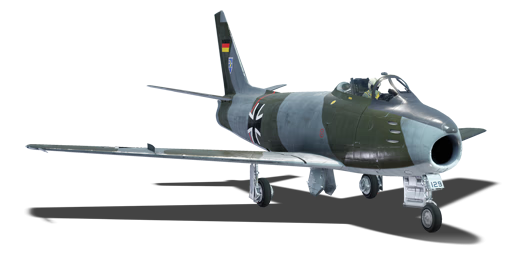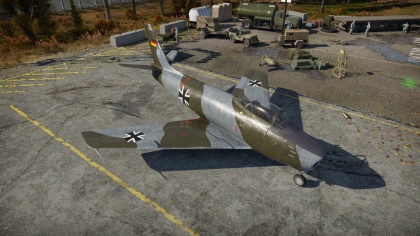CL-13A Mk 5 (Germany)
Contents
| This page is about the aircraft CL-13A Mk 5 (Germany). For other uses, see F-86 (Family). |
Description
The ◄CL-13A Sabre Mk 5 is a Rank VI German jet fighter
with a battle rating of 8.3 (AB), 8.7 (RB), and 9.0 (SB). It was introduced in Update 1.39.
General info
Flight Performance
Describe how the aircraft behaves in the air. Maximum speed, maneuverability, speed and allowable loads - these are the most important characteristics of the vehicle.
| Characteristics | Max Speed (km/h at 0 m - sea level) |
Max altitude (metres) |
Turn time (seconds) |
Rate of climb (metres/second) |
Take-off run (metres) | |||
|---|---|---|---|---|---|---|---|---|
| AB | RB | AB | RB | AB | RB | |||
| Stock | 1,103 | 1,097 | 14700 | 23.7 | 24.0 | 59.8 | 49.3 | 650 |
| Upgraded | 1,123 | 1,114 | 23.7 | 24.0 | 59.8 | 49.3 | ||
Details
| Features | |||||
|---|---|---|---|---|---|
| Combat flaps | Take-off flaps | Landing flaps | Air brakes | Arrestor gear | Drogue chute |
| ✓ | ✓ | ✓ | ✓ | X | X |
| Limits | ||||||
|---|---|---|---|---|---|---|
| Wings (km/h) | Gear (km/h) | Flaps (km/h) | Max Static G | |||
| Combat | Take-off | Landing | + | - | ||
| 0 | 350 | 620 | 620 | 350 | ~12 | ~6 |
| Optimal velocities (km/h) | |||
|---|---|---|---|
| Ailerons | Rudder | Elevators | Radiator |
| < 850 | < 600 | < 650 | N/A |
Engine performance
| Engine | Aircraft mass | |||||
|---|---|---|---|---|---|---|
| Engine name | Number | Empty mass | Wing loading (full fuel) | |||
| Avro Canada Orenda 10 | 1 | 5,330 kg | 235 kg/m2 | |||
| Engine characteristics | Mass with fuel (no weapons load) | Max Takeoff Weight | ||||
| Weight (each) | Type | 7m fuel | 20m fuel | 24m fuel | ||
| 1,160 kg | Axial-flow turbojet | 5,716 kg | 6,412 kg | 6,626 kg | 9,530 kg | |
| Maximum engine thrust @ 0 m (RB / SB) | Thrust to weight ratio @ 0 m (108%) | |||||
| Condition | 100% | WEP | 7m fuel | 20m fuel | 24m fuel | MTOW |
| Stationary | 2,818 kgf | N/A | 0.49 | 0.44 | 0.43 | 0.30 |
| Optimal | 2,818 kgf (0 km/h) |
N/A | 0.49 | 0.44 | 0.43 | 0.30 |
Survivability and armour
- 6.35 mm steel - in front of cockpit
- 12.7 mm steel - pilot's seat
- 20 mm steel - pilot's head rest
- 38 mm bulletproof glass - armoured windscreen
- Engine and fuel tanks take up most of fuselage
- More fuel tanks in wings
Armaments
Offensive armament
The CL-13A Mk 5 (Germany) is armed with:
- 6 x 12.7 mm Browning M3 machine guns, nose-mounted (300 rpg = 1,800 total)
Suspended armament
The CL-13A Mk 5 (Germany) can be outfitted with the following ordinance:
- Without payload
- 16 x 127 mm HVAR rockets
- 2 x 1,000 lb AN-M65A1 Fin M129 bombs (2,000 lb total)
Usage in the battles
Speed is everything. Reach around 1000 kph and then 10 to 20 degree climb then level out before dropping below 750 kmh IAS.
Watch out for planes like F-86F-2 Sabres and Hunters. These two you'll see the most and they will see you as a big threat since you pretty much out-perform them in every aspect. Destroy them before they pose any threat to you.
The CL-13's energy fighting capabilities outperform most if not all enemies of the same BR. Engagements should always occur on your terms, if you are in a bad situation make use of the Mk. 5's acceleration and roll rate to pull away if possible, then re-engage in an advantageous position.
The Mk.5's main pitfall is its lackluster armament of six M3 machine guns. Often, sustained fire is the only way to down an enemy short of a pilot snipe. Snapshots will often result in a few hits and an enemy still very much in the fight. However, the high velocity and large ammo count makes accuracy a secondary concern. Pilots should not hesitate to douse their enemies in a hail of machine gun fire, as even a few hits can cripple the enemy and open them up for a second, fatal pass. Engaging in head-on passes with enemies sometimes leads to success owing to the velocity of the M3s, but pilots should be careful to start firing at significant distance and peel off before the 1.0 km mark to avoid enemy fire. Whilst dogfighting, the best shot of finishing engagements lies in exploiting the CL-13's energy superiority and forcing the enemy to bleed speed to the point where they are sitting ducks for your guns. This should not come at the cost of losing one's own speed, however, as the Mk. 5's high speed maneuverability falls off very quickly and can leave you as the sitting duck instead.
Manual Engine Control
| MEC elements | ||||||
|---|---|---|---|---|---|---|
| Mixer | Pitch | Radiator | Supercharger | Turbocharger | ||
| Oil | Water | Type | ||||
| Not controllable | Not controllable | Not controllable | Not controllable | Separate | Not controllable | Not controllable |
Modules
| Tier | Flight performance | Survivability | Weaponry | ||
|---|---|---|---|---|---|
| I | Fuselage Repair | Radiator | Offensive 12 mm | ||
| II | Compressor | Airframe | FRC mk.2 | ||
| III | Wings Repair | Engine | New 12 mm MGs | ||
| IV | Engine Injection | Cover | FLBC mk.1 | ||
Pros and cons
Pros:
- Excellent roll rate at all speeds.
- Flying tail elevator provides insane maneuverability at higher speeds.
- High velocity heavy machine gun armament.
- High rate of fire .50 cal M3 machine guns.
- Turn rate is very good (not better than F-86A-5/F-40 Sabre).
- Very good climb rate against all jets.
- Better acceleration than most 9.0 jets, accelerating more than any other Sabre in game.
- All round aircraft (good at AB, RB, and SB).
Cons:
- Low speed maneuverability worse than earlier jets.
- Installed boosters breaks your wings if pulled over 12 G.
- Weak landing gears.
- Its excessive flight performance very often causes overconfidence, which can prove deadly.
History
Describe the history of the creation and combat usage of the aircraft in more detail than in the introduction. If the historical reference turns out to be too big, take it to a separate article, taking a link to an article about the vehicle and adding a block "/ historical reference" (example: https://wiki.warthunder.com/Name-vehicles/historical reference) and add a link to it here using the main template. Be sure to include links to sources at the end of the article.
The CL-13 Series
The CL-13 series of aircraft were built by Canadair under licence from North American Aviation. These fighters would be operated by Canada until 1958, and a variety of other nations until much later, with the last variants being retired by the Pakistani Air Force in 1980. There were two major production runs of the aircraft. The first, the Mk. 2 and Mk. 4's with just under 1,000 built, were very similar to their US counterparts, differing only in minor details. The second run, the Mk. 5's and Mk. 6's of similar numbers, were patterned on the later versions of the US Sabre with larger wings for improved maneuverability while replacing the original General Electric J47 engine with the locally-designed more-powerful Avro Canada Orenda. The Mk. 6, with a more powerful version of the Orenda, is widely considered the best of all Sabres.
The CL-13 Mk. 5
On 30 July 1953, the first Sabre Mk.5 flew with the Orenda 10 engine, which gave it a clear rate of climb and ceiling advantage over earlier variants. Other Mk 5 improvements included a new oxygen system and improved maneuverability and low-speed characteristics achieved by increasing the wing chord by six in (15.2 cm) at the root and three in. (7.2 cm) at the wing tip along with fitting a small vertical wing fence. This modification, originated by North American on the F-86F, dramatically improved maneuverability, though the loss of the slatted leading edge increased landing speed and degraded low speed handling considerably. Canadair built 370 Mk 5s with the majority designated for use in the RCAF's Air Division squadrons in Europe to replace the Mk.2s.
Service in the Luftwaffe
In 1956 the newly-revived West German Luftwaffe ordered 225 Canadair CL-13 Mk. 6s to equip 3 day-fighter wings. In order to jump-start the effort, 75 ex-RCAF Mk 5s were supplied to the Luftwaffe in 1957/58, where they served with the Waffenschule 10 training unit that was assigned the task of conversion of pilots to the Canadair Sabre. From a peak of 65 airworthy Mk 5s in January of 1959, the Luftwaffe inventory had declined to about 25 by April of 1960. The last Luftwaffe Sabre Mk.5s were disposed of in March of 1962, and most were scrapped.[1]
Media
An excellent addition to the article will be video guides, as well as screenshots from the game and photos.
See also
- Related development
- Canadair Sabre (those Sabres manufactured with the designator "CL")
- North American F-86A/F
- North American F-86D Sabre
- North American F-100 Super Sabre
- North American FJ-4 Fury
- Aircraft of comparable role, configuration and era
- Dassault Super Mystère
- Grumman F-9 Cougar
- Hawker Hunter
- Lavochkin La-15
- Mikoyan-Gurevich MiG-15
- Mikoyan-Gurevich MiG-17
- Saab J29 Tunnan
External links
Paste links to sources and external resources, such as:
- topic on the official game forum;
- page on aircraft encyclopedia;
- other literature.
| Canadair Limited | |
|---|---|
| Fighters | ▄CL-13 Mk.4* · ◄CL-13A Mk 5* · ◄CL-13B Mk.6* |
| * These aircraft were license-built from North American Aviation who developed and built the F-86 Sabre fighter. | |
| Germany jet aircraft | |
|---|---|
| |
Luftwaffe |
| He 162 | He 162 A-1 · He 162 A-2 |
| Me 163 | Me 163 B · Me 163 B-0 |
| Ho 229 | Ho 229 V3 |
| Ar 234 | Ar 234 B-2 · Ar 234 C-3 |
| Me 262 | Me 262 A-1a · Me 262 A-1a/Jabo · Me 262 A-1a/U1 · Me 262 A-1/U4 · Me 262 A-2a |
| Me 262 C-1a · Me 262 C-2b | |
| |
LSK |
| Fighters | ◊MiG-15bis · ◊Lim-5P · ◊MiG-19S |
| ◊MiG-21MF · ◊MiG-21bis-SAU · ◊MiG-21 "Lazur-M" | |
| ◊MiG-29 | |
| Attackers | ◊MiG-23BN · ◊MiG-23MF · ◊MiG-23MLA |
| ◊Su-22UM3K · ◊Su-22M4 | |
| ◊IL-28 | |
| |
Luftwaffe |
| F-84 | ◄F-84F |
| F-86 | ◄CL-13A Mk 5 · ◄CL-13B Mk.6 · ◄F-86K |
| F-104 | ◄F-104G |
| F-4 | ◄F-4F Early · ◄F-4F · ◄F-4F KWS LV |
| G.91 | ◄G.91 R/3 · ◄G.91 R/4 |
| Tornado | ◄Tornado IDS WTD61 · ◄Tornado IDS MFG · ◄Tornado IDS ASSTA1 |
| Other | Alpha Jet A · ◄Sea Hawk Mk.100 |
| Ex-LSK | ◄MiG-21 SPS-K · ◄MiG-29G · ◄Su-22M4 WTD61 |
| |
Swiss Air Force |
| ◌Hunter F.58 · FFA P-16 | |





